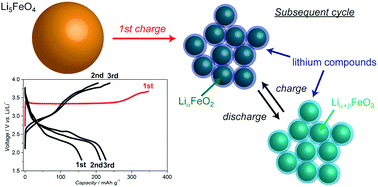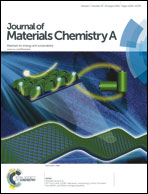Effect of bulk and surface structural changes in Li5FeO4 positive electrodes during first charging on subsequent lithium-ion battery performance†
Abstract
Bulk and surface structural changes induced in a Li5FeO4 positive electrode with a defect anti-fluorite type structure are examined during its initial charge–discharge cycle by various synchrotron-radiation analysis techniques, with a view to determining the contribution of oxygen to its electrochemical properties. Bulk structural analyses including XRD, Fe K-edge XANES and EXAFS reveal that pseudo-cubic lithium iron oxides (PC-LFOs), in the form of LiαFe(4−α)+O2, are formed during the first charging process instead of the decomposition of pristine Li5FeO4. Moreover, the relative volume of this PC-LFO phase varies nonlinearly according to the charging depth. At the same time, the surface lithium compounds such as Li2O cover over the PC-LFO phase, which also contribute to the overall electrochemical reaction, as measured from the O K-edge XANES operating in a surface-sensitive total-electron yield mode. The ratio of these two different reaction mechanisms changes with the depth during the first charging process, with this tendency causing variation in the subsequent discharge capacity retention in relation to the depth of the charging electron and/or temperature of this “Li-rich” positive electrode. Indeed, such behaviour is noted to be very similar to the specific electrochemical properties of Li2MnO3.

- This article is part of the themed collection: 2014 Journal of Materials Chemistry A Hot Articles

 Please wait while we load your content...
Please wait while we load your content...